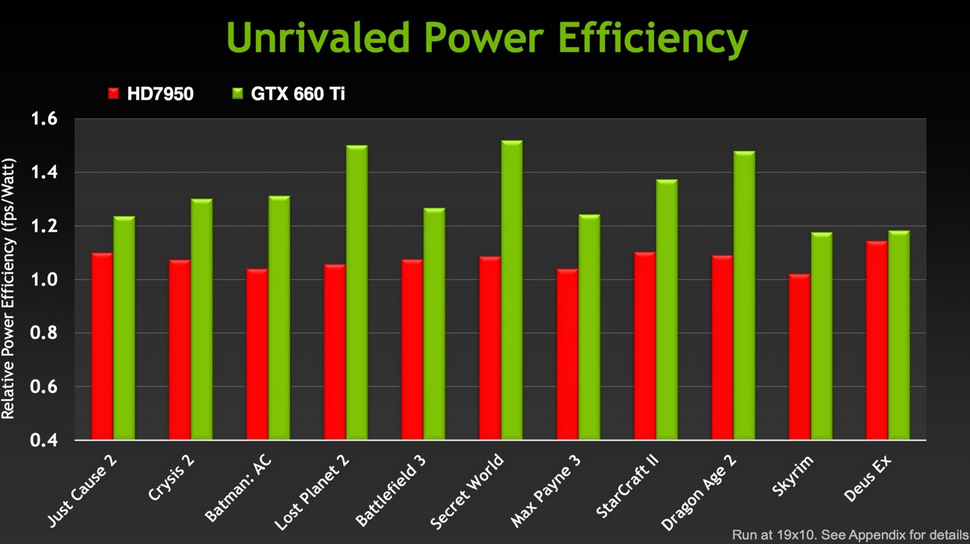Kepler's initial GTX 670 and GTX 680 may have been prohibitively expensive for some gamers, but the GTX 660 Ti is now here, and we've got the specs comparison of the GTX 660 Ti, GTX 670, and GTX 680.
The 660 Ti is nVidia's new mid-range GPU, planned to ship at $300, and nVidia has a lot to live up to -- the company said at its announcement that the GTX 660 Ti is the "best card per watt ever made," and at 150W, the 28nm CUDA microarchitecture with similar core structure to the GTX 670 may mean that's true.
nVidia GeForce GTX 660 Ti Specs
Let's hit the hard specs of this new graphics competitor:
| CUDA Cores | 1344 |
| Base Clock | 915 MHz |
| Boost Clock | 980 MHz |
| Memory Config | 2GB / 192b GDDR5 |
| Memory Speed | 6.0 Gbps |
| Power Connectors | 2x6-pin |
| TDP | 150W |
| Outputs | 2x DL-DVI HDMI Displayport 1.2 |
| Bus Interface | PCI-e 3.0 |
Nvidia stresses a marketing focus on taking advantage of Dx 11's capabilities, including Dx 11 tessellation and the use of TXAA (see the slides below). Other Kepler cards are also capable of these advancements, of course, but the 660 Ti is one of the first cards to offer the level of performance it boasts at a $300 price.
Take these relative performance charts with a grain of salt as they were created by nVidia and are, no doubt, tested with some bias, but they still give a good foundation for the 660 Ti.
nVidia Testing Settings
All of nVidia's tests were run with the following hardware:
- Motherboard: Rampage IV Extreme (x79)
- CPU: 3960X-3.3GHz
- RAM: 8GB Corsair DDR3
- SBIOS: 0803
- GeForce Driver: 304.73
- Radeon Driver: Catalyst 12.7 Beta
The game settings for the games listed are as follows:
nVidia GTX 660 Ti vs. GTX 470 (Kepler vs. Fermi)
This chart features an older card in the Fermi line - the GTX 470, which is still being used by upwards of 4.92% of gamers on Steam, according to the hardware survey, making it the second most utilized Dx11 GPU.
[GTX 660 FERMI]
nVidia GTX 660 Ti vs. AMD Radeon HD 7870
The 560 Ti held a small performance advantage over the 6870, in some instances, so if the last generation is any precursor to now, the results aren't too surprising. At best, the GTX 660 Ti performed nearly 1.4x better (in FPS) than the 7870 in The Secret World; approximately 1.2x better in Battlefield 3 and Crysis 2.
The boost isn't necessarily large, but going forward it may be relevant - a difference between 20 FPS and 30 FPS can be the difference between playability and decrease graphics.
Nvidia's chart shows the GTX 660 Ti's relative performance in Just Cause 2, Crysis 2, Batman: AC, Lost Planet 2, Battlefield 3, TSW, Max Payne 3, StarCraft 2, Skyrim, Dragon Age 2, and Deus Ex.
nVidia GTX 660 Ti vs. AMD Radeon HD 7950
Using the same games as listed above, nVidia ran a similar test between their 660 Ti and the HD 7950. Again, keep marketing bias in mind when reviewing this information.
nVidia GTX 660 Ti Power Efficiency - FPS-per-Watt
To flex their wattage efficiency muscles a bit, nVidia also released this graph -- for reference, the HD 7950 operates at around 200W; the 660 Ti is marketed at 150W.
Spec Comparison - GTX 660 Ti, GTX 670, GTX 680
Specifications | EVGA GTX 660 Ti 2GB | GTX 670 2GB | GTX 680 2GB |
Graphics Cores | 1344 | 1344 | 1536 |
Texture Units | 112 | 112 | 128 |
ROPs | 24 | 32 | 32 |
Base Clock Frequency | 980 | 915 MHz | 1006 MHz |
Boost Clock Frequency | 1059 | 980 MHz | 1058 MHz |
Memory (Frequency) | 2GB (1,502MHz) | 2GB GDDR5 (1,502 MHz) | 2GB GDDR5 (1,502 MHz) |
Memory Interface | 192-bi | 256-bit | 256-bit |
Transistor Count | 3.5 billion | 3.5 billion | 3.5 billion |
Display Connectors | 2 x Dual Link DVI, 2 x HDMI 1.4a (Fast), 2 x DisplayPort 1.2 | 2 x Dual Link DVI, 2 x HDMI 1.4a (Fast), 2 x DisplayPort 1.2 | 2 x Dual Link DVI, 2 x HDMI 1.4a (Fast), 2 x DisplayPort 1.2 |
Power Connectors | 2 x 6-pin PCIe | 2 x 6-pin PCIe | 2 x 6-pin PCIe |
Thermal Design Power (TDP) | 150W | 170W | 195W |
GTX 660 Ti Benchmark - Metro 2033
While we haven't had a chance to benchmark the new addition to the Kepler family, the team over at TechPowerUp have. Here's what their real-world bench in Metro 2033 found:

Our thoughts on all this? It's certainly shaping up to be a great card for the gap -- we've been waiting for that $300 price range to be filled with a powerful current-gen card for a while now, so hopefully this is it.
Have questions about the GTX 660 Ti? Post them below and we'll make sure they're answered.




